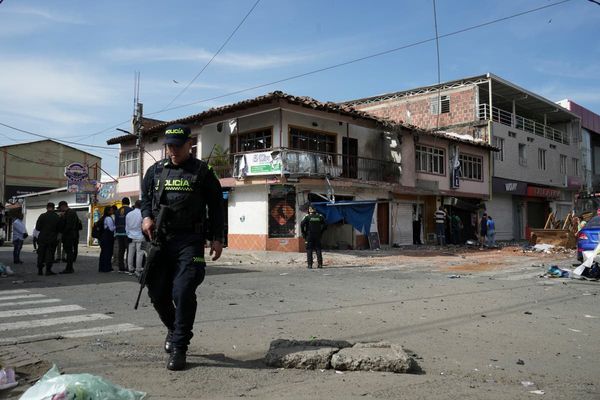
An explosive device was thrown on to the porch of the Satanic Temple and caused cosmetic damage to the building early on Monday – but the device failed to detonate successfully and was only found hours later, according to police in Massachusetts.
Police in the town of Salem have since said that the situation had been contained and that there was no ongoing threat after office had closed access for several hours to the block on Bridge Street where the targeted building is.
“State police bomb technicians ensured that the device was no longer a danger and explosive ordinance detection K9s swept the location for secondary devices,” police said in a statement.
Lucien Greaves, a spokesperson and co-founder of the Satanic Temple, told local news station WBZ that it was fortunate that the building was left with only a scorched side.
“It can’t be overstated that this was definitely a horrific act of attempted terrorism and people could be hurt,” Greaves told the outlet.
Greaves told the Boston Globe that the device had “fizzled out, scorching some of the front of the house” – and that police swarmed the scene as well as gathered all the available evidence, including security footage.
He added that he had given a private tour of the temple to two individuals before the device was discovered. “We came in through the back and did the whole tour, and all the while, on the front deck, I guess, was this bomb,” he told the outlet.
Salem became famous for trials in 1692-93 that saw 200 people accused of practicing witchcraft. Thirty people were found guilty, and 19 of them – 14 women and five men – were executed by hanging.
“What a sad thing it is to see eight firebrands of hell hanging there,” Nicholas Noyes, a clergyman known as “the Teacher” who oversaw the executions, was quoted as saying after one mass hanging.
A number of theories have been presented for the outbreak of hysteria, including that it was caused by economic stresses on a colonial society that was rapidly transforming from agrarian to pre-industrial.
Salem’s Satanic Temple – which property zoning officials have classified as an art gallery and sits less than a mile from where the 17th-century hangings took place – opened in 2013. It serves as the organization’s international headquarters as well as a bed and breakfast.
“The history of Salem is also part of the history of satanism,” Greaves told the Globe in 2016. Salem, he added, was “a very appropriate place” for a temple, although the group describes itself as a “non-theistic religious organization”.
Greaves went on to explain that satanism had been misunderstood by American society. He said satanists viewed Satan as a literary figure representing an eternal struggle against authoritarianism – rather than the literal devil antagonizing God and God’s believers.
After Monday’s attack, Greaves told the Globe that the group finds “a real power in the mythology of Satan, but from a Miltonian perspective in which Satan is the ultimate rebel against tyranny”, Greaves said, referring to John Milton’s Paradise Lost.
“So to that end, we’re often fighting to preserve free speech liberties and equal access liberties, and true religious freedom, which means government neutrality insofar as religious perspective is concerned,” he added.
Known as the Witch City, Salem has developed a tourist trade as a cultural destination for Wiccans, warlocks, satanic new-agers and occultists.
But the Satanic Temple group, known as TST, has been subject to ongoing lawsuits at its satellite locations in Texas, Arizona, Arkansas, Boston, Missouri and other states. In January, an Iowa man was charged with a hate crime after being accused of destroying a statue of a pagan idol erected by the Satanic Temple group in Des Moines under laws guaranteeing religious freedom.
In 2022 in Salem, a man named Daniel Lucey admitted to setting a fire at the temple. Lucey confessed to police and stated “this is a hate crime”.
He is said to have been wearing a T-shirt that displayed the word “God” at the time of the intentionally set blaze.
Lucey reportedly returned to the temple when police began investigating and was arrested him on charges of arson of a dwelling, a civil rights violation and destruction of a place of worship.
He later told police he was planning to turn himself in and “wouldn’t lose sleep” if members of the temple had been hurt.
Police found a Bible, lighter fluid, sticks and a copy of the constitution in his backpack.
After the latest Salem attack on Monday, Greaves told the Globe that the attempted firebombing was “certainly a terroristic threat”.
“People could have been hurt,” Greaves remarked. “I don’t know how anybody could feel that they are justified in doing anything like this.”






